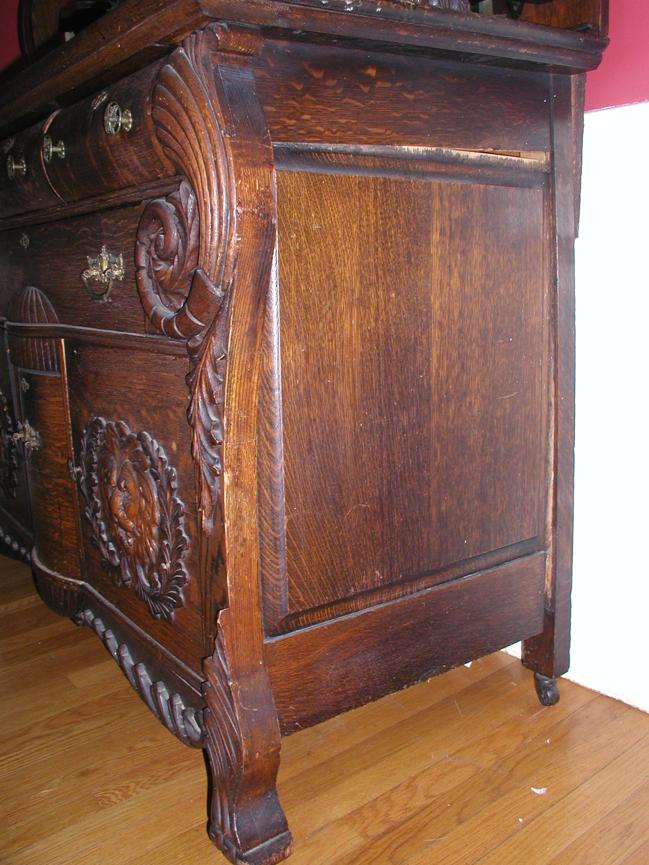
Q. We’re liking your column! I have two unrelated questions:
1. A chimney sweep company said our chimney has cracks and needs a liner. I remember reading years ago that liners are not necessarily a good idea, and I’d actually rather have someone fix the chimney if that’s feasible. What’s your unbiased opinion? The house was built in 1927. It has gas heat and hot water and a working fireplace.
2. Someone yanked on the leg of my heavy-as-lead sideboard (a 100-plus-year-old family piece), and it pulled away. Can I fix this myself?
Make that three unrelated questions: Are you related to Duke Robillard, the blues guitarist?
PAM, Belmont
A. Your chimney probably would benefit from a liner. The flue is nearly 90 years old and is venting gas, which can produce corrosive condensate. Time is not on its side, and lining is always a good idea if your flue is in poor condition. Before I did anything, though, I would look at the bigger picture. How old is your heating system? Will you be replacing it soon? Some new systems don’t even use the chimney, so you could remove it when remodeling to create more room in your home.
Regarding the sideboard: In my experience, most well-made furniture can be repaired. It’s tough to say whether glue or nails are the right approach here. I’d like to know how the unit was constructed, because that would determine which fasteners you should use and where you can hide them. It’s really tough to diagnose without inspecting the damage and condition of the mortise and tenon. If you were able to spread the panel apart enough to clean out the old glue and debris, you may have a solid chance of repairing this. You can use a combination of razor blades, small chisels, and sandpaper to clean off the old glue. Be sure the surface to be glued is as clean (bare wood is ideal) as possible. Dry-fit the pieces before applying the glue to ensure they actually go together well. Use wood or hide glue. A glue needle applicator or small brush is helpful in tight spaces. The brush ensures equal coverage on the tenon and inside the mortise. Band straps will work to hold the parts together while the glue dries. It is important to protect the furniture piece when clamping; use wood, cloth, or wax paper as a barrier.
I get asked about Duke Robillard a lot. There is no relation, although I do play a mean air guitar.
Q. We just downsized to a home in Shrewsbury, and I have two questions:
1. It has vinyl siding, but the eaves do not have soffits for ventilation. Someone must have chipped away at ice because the shingles are nicked. What would be the best way to determine what is under the vinyl on the eaves and to add soffits?
2. Our heat is forced hot water by gas. In one room, there aren’t any fins on the ¾-inch copper tubing. Will adding them help retain more heat? I cannot find a place to purchase them.
MARTY RYAN
A. There is no reason to peek under the siding. If you want to add soffits, you can do that, but they will extend your roof angle out from its current position and could interfere with the windows below. If you have at least 10 inches of clearance, then go for it; add your soffit and a continuous soffit-venting strip. I suggest that you also remove a foot or so of the shingles and plywood sheathing. After building the soffit, install new sheathing all the way up to the point where you began the cutout. Add an ice and water shield and a drip edge, and tie in your new shingles.
Note: A great time to do this work would be when replacing your shingles. If your roof does not have an ice and water shield, you may want to peel the shingles back even higher and add 3 feet of it.
Adding fins will increase your heat efficiency. Many plumbers will do a loss survey to determine how much heat is needed in a room and can advise you. Regarding your question on where to find fins, they come in a kit that includes the baseboard covers. A plumber will drain your system, cut out some of the existing pipe, and insert the new cover and fin radiator, screwing the cover assembly to the wall. You can get these at a plumbing supply store.
Dear Rob
I stand hat in hand and offer my thanks to the readers who pointed out that I was wrong about who owns the wiring from the electrical pole to the meter box (“Are your lights flickering? When you should call an electrician,’’ Feb. 21). Eversource offers this explanation to its customers: “With the exception of the meter, the wires and equipment that run from the connection point into a residence are the responsibility of the customer.’’ Municipal utilities might have a different setup.
Rob Robillard is a general contractor, carpenter, editor of AConcordCarpenter.com, and principal of a carpentry and renovation business. Send your questions to homerepair@globe.com or tweet them to @globeaddress or @robertrobillard.



